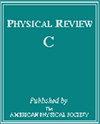Semiclassical approach for nuclear Coulomb excitation
IF 3.4
2区 物理与天体物理
Q1 Physics and Astronomy
引用次数: 0
Abstract
Nuclear Coulomb excitation is often calculated using a semiclassical (SC) approach, where the projectile follows classical trajectories and excites the target nucleus through a time-dependent Coulomb interaction. While the validity of the SC approach has been well established for electric quadrupole () transitions, its accuracy for higher-order multipole transitions remains insufficiently benchmarked. In this paper, we compare Coulomb excitation cross sections for higher-order multipole transitions calculated using the SC approach with those obtained through a quantum mechanical (QM) approach, where the projectile is described by wave functions. For transitions, the excitation cross sections from both approaches are of the same order of magnitude, consistent with existing validations. However, for higher-order multipole transitions, the SC approach yields significantly higher cross sections, deviating possibly by orders of magnitude from the QM results. This discrepancy underscores the necessity of the QM approach for accurate calculations of the Coulomb excitation cross sections. The failure of the SC approach is explained through using the Wentzel-Kramers-Brillouin approximation.

核库仑激发的半经典方法
核库仑激发通常采用半经典(SC)方法进行计算,即射弹遵循经典轨迹,通过随时间变化的库仑相互作用激发靶核。虽然半经典方法在电四极(E2)跃迁方面的有效性已得到充分证实,但其在高阶多极跃迁方面的准确性仍未得到充分基准测试。在本文中,我们将利用 SC 方法计算的高阶多极跃迁的库仑激发截面与通过量子力学(QM)方法获得的截面进行了比较,在量子力学方法中,射弹是由波函数描述的。对于 E2 变换,两种方法得到的激发截面数量级相同,与现有的验证结果一致。然而,对于更高阶的多极跃迁,SC 方法得到的截面明显更高,与 QM 方法的结果可能有数量级的偏差。这种差异突出表明,要精确计算库仑激发截面,就必须采用量子力学方法。通过使用 Wentzel-Kramers-Brillouin 近似,可以解释 SC 方法的失败。
本文章由计算机程序翻译,如有差异,请以英文原文为准。
求助全文
约1分钟内获得全文
求助全文
来源期刊

Physical Review C
物理-物理:核物理
CiteScore
5.70
自引率
35.50%
发文量
0
审稿时长
1-2 weeks
期刊介绍:
Physical Review C (PRC) is a leading journal in theoretical and experimental nuclear physics, publishing more than two-thirds of the research literature in the field.
PRC covers experimental and theoretical results in all aspects of nuclear physics, including:
Nucleon-nucleon interaction, few-body systems
Nuclear structure
Nuclear reactions
Relativistic nuclear collisions
Hadronic physics and QCD
Electroweak interaction, symmetries
Nuclear astrophysics
 求助内容:
求助内容: 应助结果提醒方式:
应助结果提醒方式:


